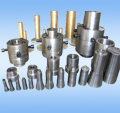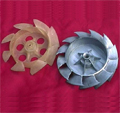

| Address: | PDS Enterprise Inc. 1650 West Artesia Blvd, Suite 278 Gardena, CA90248 |
| Phone: | 1-843-408-0142 |
| Email: | pdsenterprise@gmail.com sales@coolprototyping.com |


Home>Glossary
265. Die casting process
Die casting is the process of forcing molten metal under high pressure into mold cavities (which are machined into dies). Most die castings are made from non-ferrous metals, specifically zinc, copper, aluminium, magnesium, lead, and tin based alloys, although ferrous metal die castings are possible. The die casting method is especially suited for applications where a large quantity of small to medium sized parts are needed with good detail, a fine surface quality and dimensional consistency.There are four major steps in the die casting process. First, the custom molds is sprayed with lubricant and closed. The lubricant both helps control the temperature of the die and it also assists in the removal of the casting. Molten metal is then shot into the die under high pressure; between 10-175 MPa (1,500-25,000 psi). Once the die is filled the pressure is maintained until the casting has solidified. The die is then opened and the shot (shots are different from castings because there can be multiple cavities in a die, yielding multiple castings per shot) is ejected by the ejector pins. Finally, the scrap, which includes the gate, runners, sprues and flash, must be separated from the casting(s). This is often done using a special trim die in a power press or hydraulic press. Another method is separating by hand or by sawing, which case grinding may be necessary to smooth the scrap marks. A less labor-intensive method is to tumble shots if gates are thin and easily broken; separation of gates from finished parts must follow. This scrap is recycled by remelting it. Approximately 15% of the metal used is wasted or lost due to a variety of factors.
The high-pressure injection leads to a quick fill of the die, which is required so the entire cavity fills before any part of the casting solidifies. In this way, discontinuities are avoided even if the shape requires difficult-to-fill thin sections. This creates the problem of air entrapment, because when the mold is filled quickly there is little time for the air to escape. This problem is minimized by including vents along the parting lines, however, even in a highly refined process there will still be some porosity in the center of the casting.
Secondary operations to produce features not readily castable, such as CNC machining, drillig & tapping holes, polishing, plating, buffing, or painting are available.
Here are some samples we have done before, please kindly take a look:
 We are constantly looking for new products in order to grow our business and Invention Home has enabled us to streamline that process much more quickly.
We are constantly looking for new products in order to grow our business and Invention Home has enabled us to streamline that process much more quickly. Marsha Dunmyre
CA, U.S.A
BROWSE MORE
Cool Prototyping provides "one-stop" product design service: rapid prototyping, plastic molds, custom molds, production tooling and plastic molding.
Cool Prototyping Copyright 2008-2009 © All Rights Reserved. Rapid Prototyping
Cool Prototyping Copyright 2008-2009 © All Rights Reserved. Rapid Prototyping






